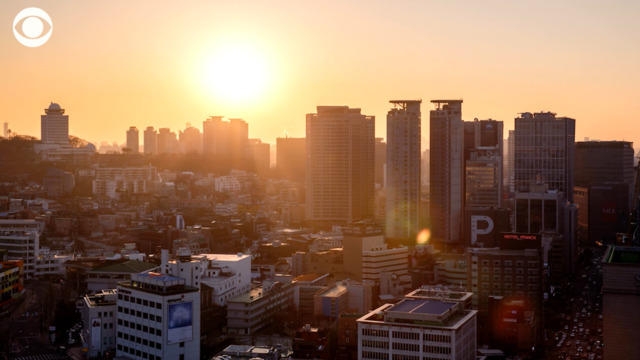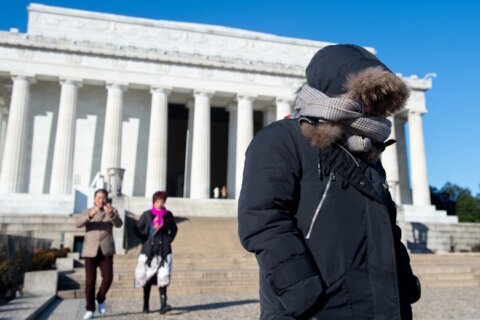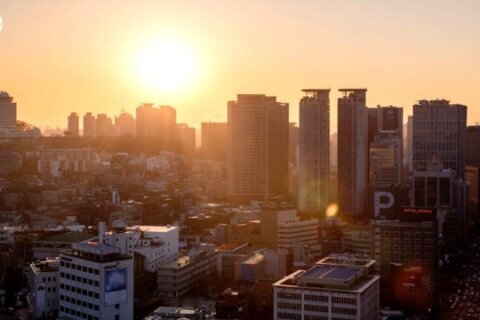
The deadly heat waves in back-to-back summers have left people throughout the U.S. and Europe desperate for relief. It’s urban centers that have felt the intense temperatures the most — and where experts say it’s only expected to get worse.
That’s because of something called the urban heat island effect.
“Simply put, it means that urban centers are hotter than the surrounding suburban areas,” Liv Yoon, a postdoctoral research scholar at Columbia University’s Climate School, told CBS News. She explained that the effect is like a “dome overarching the city” that’s created by carbon emissions, air getting trapped amid tall buildings, and a lack of open space and greenery, among other things.
“All of that is building and building and it has nowhere to escape,” she said.
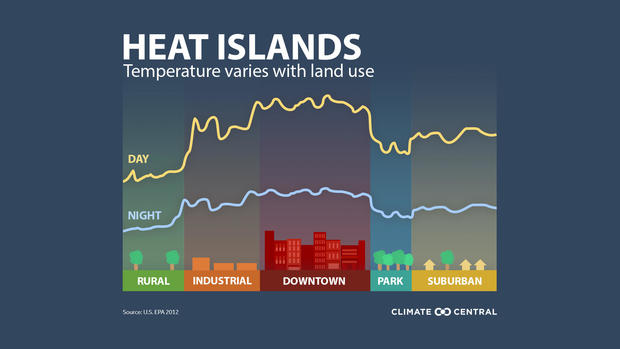 This image shows how the temperature can differ between rural, industrial, downtown, park and suburban areas on the same day.
This image shows how the temperature can differ between rural, industrial, downtown, park and suburban areas on the same day.
Climate Central
This dome effect can cascade over entire cities, although it also impacts specific neighborhoods within that urban area very differently. According to heat.gov, neighborhoods in the same city can have temperatures differing by roughly 15 to 20 degrees Fahrenheit at the same time depending on their levels of tree cover and other factors.
Pretty much every metropolitan area experiences this effect to some degree. About 85% of the U.S. population currently lives in metro areas, and the heat island effect is felt most intensely in New Orleans, New York City, Houston, San Francisco and Newark, New Jersey, according to a 2021 report by the nonprofit Climate Central.
Phoenix, Arizona, is also a city that experiences this effect. It’s partially to blame for the triple-digit temperatures that have plagued the city every single day in July – a problem that’s expected to persist through at least the end of the month. On Tuesday and Wednesday, the National Weather Service expects Phoenix will smash two more records, blowing past the daily record highs for those days.
“Today, there are over 200 to 250 million people that experience temperatures of over 35ºC [95ºF] every summer, living in about 318 urban areas” across the U.S., environmental scientist and climate resilience specialist Deborah Brosnan said. “So, it’s a lot of people experiencing it.”
Yoon, the heat island researcher, is part of a project participating in a nationwide campaign by the National Oceanic and Atmospheric Administration to “make heat visible.” Teams in various U.S. cities — including Yoon’s in New York City — have been tracking temperatures to show the impact of excessive heat and the heat island effect.
A map of their findings in New York shows how by the afternoon and evening, the heat index is substantially higher in the neighborhoods of Washington Heights, Harlem and the South Bronx when compared to the Upper East Side, Central Park and the Upper West Side.
“Within a city, just because there’s a heat wave going on, no one’s experiencing that the same exact way everywhere,” Jeremy Hoffman, an environmental science professor and scientist at the Science Museum of Virginia, told CBS News.
In his own research in Richmond, Hoffman’s team found a 16 degree Fahrenheit difference between the coolest and warmest places — less than 3 miles apart — at the exact same time during a heat wave.
The phenomenon isn’t confined to summer heat waves. It’s year-round.
“Urban areas tend to be several degrees warmer than their outlying rural areas throughout the year,” Hoffman said. “That tends to be actually kind of a good thing for our energy needs in the wintertime, but in the summertime … when it’s on our hottest days with the brightest sunshine, the least amount of wind and the least amount of cloud cover, these conditions tend to become the recipe for these extreme temperature difference to become the most stark.”
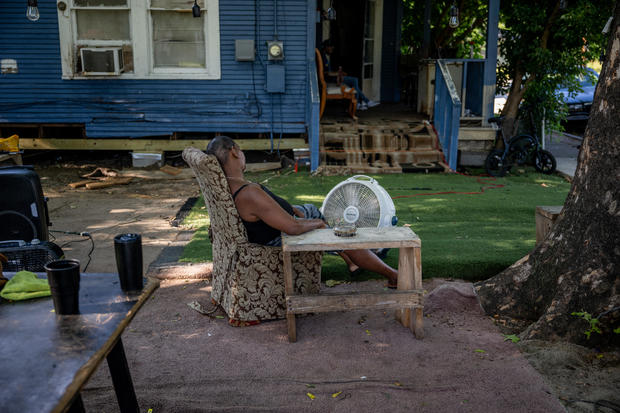 Yvette Johnson, 54, sits next to a fan outside her family’s home in Houston on June 10, 2022, when Texas was under a heat wave alert.
Yvette Johnson, 54, sits next to a fan outside her family’s home in Houston on June 10, 2022, when Texas was under a heat wave alert.
BRANDON BELL / Getty Images
“Incompatible with human life”
Ben Zaitchik, a professor of earth and planetary sciences at Johns Hopkins University, told CBS News that urban heat lingers, and is usually maximized, at night. The sustained high temperatures prevent people from getting relief when their bodies desperately need it.
The negative impact extends beyond sheer discomfort. Areas with extreme and prolonged heat see increased cases of kids with asthma going to the emergency room, older adults with chronic lung issues having complications, and decreased worker productivity because of heat exhaustion, Zaitchik said. It can also be deadly.
“There’s a literal, physiological limit, which is that once you get above a certain threshold of temperature and humidity, you can’t sweat,” he said. The body’s internal temperature is about 98.6 degrees Fahrenheit but without the ability to sweat, the body can’t cool down, and body temperature can rapidly increase to 106 degrees or more within 10 minutes, according to the Centers for Disease Control and Prevention.
“At that point, you’re really kind of incompatible with human life,” he said.
According to the CDC, high temperatures can lead to heart and lung complications, renal failure and kidney stones, and can even impact fetal health and lead to preterm birth.
Every year in the U.S., the heat causes an average of more than 700 deaths, more than 67,500 emergency department visits and more than 9,200 hospitalizations. Those who are Black or Native American have the highest rates of death, according to CDC tracking from 2004 to 2018.
 This table shows the number of heat-related deaths by race and ethnicity and the level of urbanization from 2004 to 2018 in the U.S. Those who are Black or Hispanic are shown to have the highest rates of death.
This table shows the number of heat-related deaths by race and ethnicity and the level of urbanization from 2004 to 2018 in the U.S. Those who are Black or Hispanic are shown to have the highest rates of death.
Heat-Related Deaths — United States, 2004–2018/CDC
Yoon has seen these health issues in New York, where she specifically researches the social inequities associated with extreme heat. She said that areas with more extreme heat tend to see the most heat-related deaths and illnesses, and also tend to be communities with lower income that are historically redlined.
Even in neighborhoods where the heat difference isn’t necessarily drastic, the impact can be more intense because there are fewer buffers. On the Upper East Side, for example, Yoon found that more people are likely to have climate-controlled homes or offices and have jobs consistent with good quality health care.
That’s not the case just a few miles away in the Bronx.
“People are supposed to seek refuge from the heat indoors,” Yoon said. “But if you live in dilapidated housing or public housing, they’re notorious for their lack of cooling infrastructure. You just have nowhere to go, so extreme heat becomes even more of a problem.”
Most of those who live in the Bronx are people of color, according to the U.S. Census Bureau, and the issues the borough experiences with heat echo those in similar communities nationwide.
Brosnan said that areas of lower socioeconomic status and higher populations of people of color usually have “significantly higher” heat indexes. They also usually have more air pollution, fewer green spaces, are often closer to traffic or factories, and have less cooling infrastructure.
“If you’re a single mother, if you’re from a minority race, you are more likely to experience heat stress and to be affected by extreme heat or heat waves than people in more affluent or larger percentage White areas,” she said. “And that’s the real issue, is that the impact of rising temperatures is borne disproportionately by the poor and minorities and those who can least afford to pay for them.”
“Very high level of danger”
Since 1970, 96% of the 246 locations analyzed by Climate Central have seen increases in their average summer temperatures.
“Now versus just 50, 60 years ago,” Hoffman said, “our summers are much hotter, much more intense.”
The hotter temperatures are not just a danger to public health, but to infrastructure as well, he said. It’s particularly noticeable in regions that were historically cooler but over the past few years have been sweltering under unprecedented heat.
“There is a very high level of danger right now, for vulnerable groups in particular,” Weather Channel meteorologist Carl Parker told CBS News.
When the 2021 Pacific Northwest heat wave hit, he said as an example, only two-thirds of households in the region had air conditioning. As of 2020, 12% of U.S. households didn’t have air conditioning, according to the U.S. Energy Information Administration, and of those who do, just 66% have central AC.
Described by the National Weather Service as “oppressive and unprecedented heat,” the wave brought record-breaking temperatures to the region, resulting in buckled highways and numerous deaths.
That area was among many that experienced yet another deadly surge in heat last summer. This year, the heat waves have mostly cascaded along the Southwest U.S.
“Now, suddenly, you’re looking at days on end with temperatures above 100 degrees,” Parker said. “That’s when it gets really dangerous, when you don’t have this sort of built-in infrastructure. And then even when you do have this infrastructure, sometimes it will fail.”
“Roads begin to buckle,” Hoffman said. “Airlines can’t operate because they’re unable to take off in such warm air.”
“We see things like rolling blackouts,” he added, “because so many people are needing to push their air conditioning beyond what they’re kind of used to dealing with.”
And when the infrastructure crumbles, it only compounds on the existing issues, Zaitchik said, pointing to the deadly Hurricane Ida, a Category 4 storm that trampled numerous states in 2021.
“When you look at New Orleans, where it hit landfall, the heat killed more people than the storm itself,” he said, “because the storm knocked out power and then it got really hot and then people died.”
“No city is immune”
The past few years have shown that excessive heat is a nationwide — and global — issue. Phoenix and Dallas are among U.S. cities experiencing triple-digit heat while in Florida, the heat is so bad that the ocean has warmed to a level that’s killing protected coral reefs. And in Europe, Italy is facing the “most intense heat wave” ever as Greece is evacuating thousands of people from its islands as a heat wave fuels wildfires. All of this is happening just after it was announced the world experienced the hottest June ever recorded.
“No city is immune to this,” Yoon said. “…It’s becoming more of a problem. One, temperatures are getting hotter, but two, more and more people are congregating in urban centers. So, it’s becoming more of an issue everywhere.”
Parker told CBS News that by midcentury, major cities such as Dallas, Oklahoma City, Tampa and New Orleans, will see a month or more with heat index values of 105 degrees Fahrenheit or greater. That’s less than 30 years from now. And these urban areas, where the heat is most intense, are only growing.
“As bad as it will be, in general, it’s going to be that much worse in these urban areas. … By the middle of the century, somewhere between 60 and 70% of the world’s population will be in urban areas,” Parker said. “… And that’s gonna mean a lot of dangerous weather for millions and millions of people.”
Population density will only add to the heat. And a recent report by the nonprofit research firm First Street Foundation found that a “heat belt” will soon emerge in the U.S., stretching from the Gulf Coast to Chicago and encompassing nearly one-third of U.S. adults.
“We’re already operating on a knife’s edge in a lot of ways,” Parker said. “… So the big question will be adaptation — do city planners really start thinking about what they need to do to make cities more livable as temperatures are rising?”
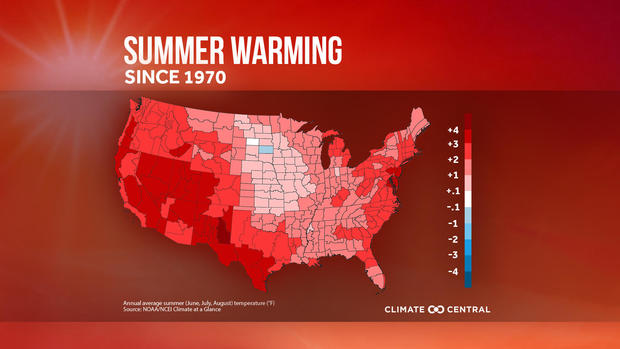 Since 1970, 96% (235) of 246 U.S. locations had an increase in their summer average temperature and 81% (200) had 7 or more summer days above normal since 1970, according to Climate Central.
Since 1970, 96% (235) of 246 U.S. locations had an increase in their summer average temperature and 81% (200) had 7 or more summer days above normal since 1970, according to Climate Central.
Climate Central
“Billions” will be exposed to hotter temperatures
Research from 2019 found that, within 30 years, the heat island effect will raise city temperatures about half of whatever they experience from climate change — and in some places, twice the amount. That means if a city’s temperature increased by 2 degrees because of climate change, it can expect an additional degree of warming because of the heat island effect.
“This previously unexamined extra warming will expose billions of urban dwellers, primarily in the tropical global South, to greater extreme heat risks,” the researchers said.
Minimizing greenhouse gas emissions is the primary way to reduce global warming as a whole. In July of last year, President Biden announced $2.3 billion in funding to help in disaster response and expand home energy assistance and offshore wind opportunities. He also signed the Inflation Reduction Act, which provides almost $400 billion to fund energy and climate projects to help reduce carbon emissions by 40% in 2030.
But in a new study, researchers say that the heat waves currently hitting the world would be “virtually impossible” if climate change wasn’t in the picture. And the situation being faced today is likely to stay – actions such as Mr. Biden’s will only work to help prevent more warming in the future; they won’t erase the damage that’s already been done. Experts say that means that the world must prepare for a new reality, and now.
“Unless cities can adapt … we will reach a situation where, at least in some cities, some of the densest cities, that it will be unsafe for people to live there during the summer,” Brosnan told CBS News.
Cities impacted by the urban heat island effect must develop three main components of heat resiliency, Brosnan said: more green spaces to provide shade and help absorb the heat; retrofit buildings to be more economical and efficient in keeping people cool during extreme heat; and finally, better assist communities during times of extreme heat by providing water, cooling centers, assistance and anything else residents might need to survive.
“It’s a long-term investment and it’s a cost,” Brosnan said, noting that all of these things will require lots of money and manpower. “The benefit is in human survival.”

